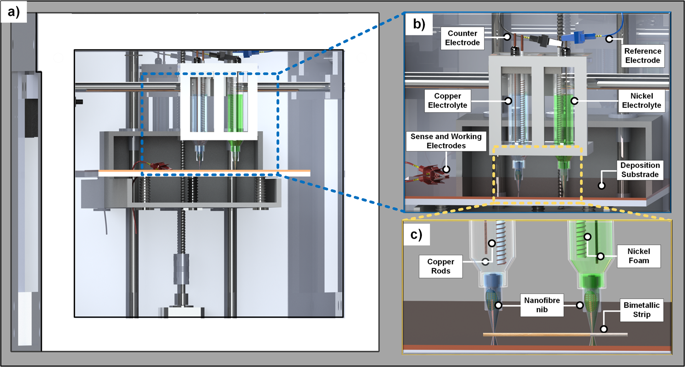

3D printing involves countless different types of hardware, software, and materials. It is the perfect medium for continual experimentation—even into a different and more unknown realm like 4D. And once there, the whole cycle of experimentation and innovation begins again with different variables. In a recent study, ‘Multi-metal 4D printing with a desktop electrochemical 3D printer,’ by Xiaolong Chen, Xinhua Liu, Mengzheng Ouyang, Jingyi Chen, Oluwadamilola Taiwo, Yuhua Xia, Peter R. N. Childs, Nigel P. Brandon, and Billy Wu, metal materials are being experimented with, rather than the usual polymers.
The authors use a new technology with a multi-metal electrochemical 3D printer, making copper/nickel bimetallic parts that respond to temperature just like other self-assembling structures. Not only are they experimenting further on the 4D printing level, but with multiple types of materials—and in metal. As the authors point out, metal 3D printing can be cost-prohibitive for many users and businesses, and there are safety risks also, caused by exposure to laser, powder particles, and exceptionally high heat.
With electrochemical additive manufacturing (ECAM), metal parts are created by deposition of metal ions from electrolyte solutions. High temperatures are not required, safety is less of an issue, and the process is more affordable; however, speed is still a challenge. Adding multiple materials and the ability to self-assemble certainly expands the goals set in this study also.
The authors outline numerous forays into 4D previously, from helical structures to corrugated parts. Hydrogen valves have been made in 4D, and other printed, ‘rigid’ objects have been made to morph via humidity. Almost all these items though have been unstable or fragile. In this study, the authors built on previous work, creating an affordable desktop electrochemical 3D printer with two nozzles from an older FDM printer, and experimenting with the following:

- Layer thickness
- Temperatures
- Deposition positions
“Further analysis into the metallic properties of the structures, such as, electrical conductivity and surface morphology is presented through scanning electron microscopy (SEM) and X-ray computed tomography (XCT),” state the researchers.
The team tested the copper bimetallic strips, paying close attention to their thermo-mechanical properties. The samples were put on a heated bed with only one end fully attached. A camera was set so the researchers could watch the samples deform as the heat increased.
“SEM imaging and EDS analysis showed that a tightly bound interface is formed between the copper and nickel layers, with printed lines exhibiting a convex cross section due to the higher reaction current density at the center of the nozzle. Optical microscopy during heating of various printed samples including Cu-Ni and Cu-Ni-Cu structures demonstrated the ability of the technique in creating different movements,” concluded the authors.
“The findings here thus present the first reported low cost, multi-metal 3D printing approach for creating high temperature 4D structures which opens the possibility for creating more intelligent structures and sensors.”
Metal 3D printing is one of the most powerful types of fabrication today, whether in titanium, carbon, or more unusual forms like copper. Designers and engineers around the world are also delving further into 4D whether through fashion and consumer products, smart, industrial metamaterials, or shape-shifting epoxy parts. What do you think of this news? Let us know your thoughts! Join the discussion of this and other 3D printing topics at 3DPrintBoard.com.
[Source / Images: Multi-metal 4D printing with a desktop electrochemical 3D printer]
If you're looking to get architectural 3D animation in the USA, our service provides an exceptional way to bring your architectural concepts to life through dynamic, immersive visuals. Through our platform, you can easily request high-quality 3D animations that showcase your designs in motion, offering a detailed view of your project from multiple angles and perspectives. Whether it's for a real estate development, a commercial building, or an urban planning project, our expert team ensures that every detail is captured in a visually compelling animation.
Through our website, you can seamlessly get architectural 3D animation tailored to your project’s specific needs. With our help, you can offer potential clients or investors an engaging experience that goes beyond static images. By integrating CGI animations with real-world settings, lighting, and textures, our team creates a lifelike experience that allows your audience to interact with your project as though it were already built. This service is perfect for presenting complex designs in a clear, visually attractive way that stands out in the competitive architectural market.




